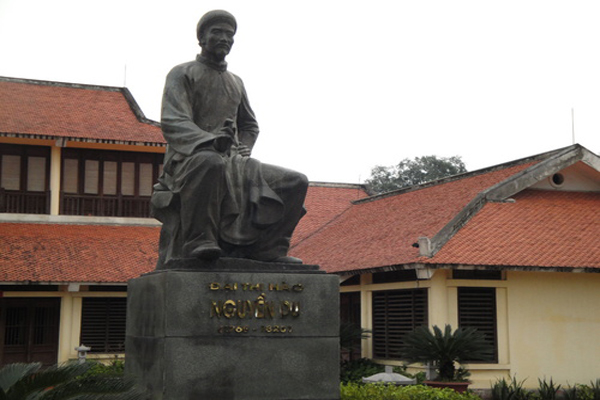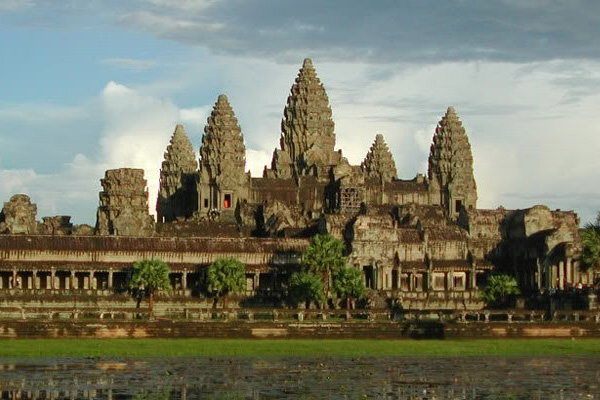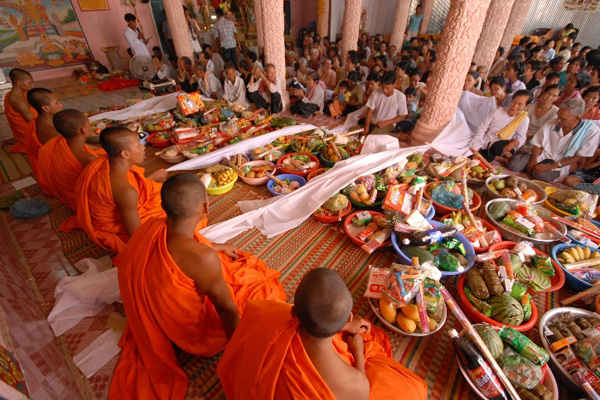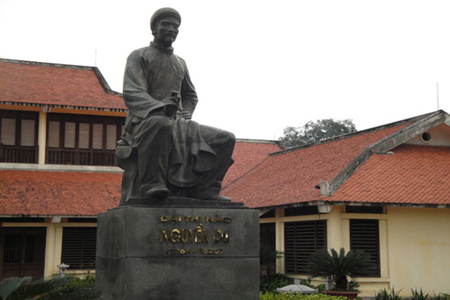Ch'an Master Lieu Quan's year of birth is unknown. He was bom in Bach Ma Village, Phu Yen. When he was small, he studied Buddhism from Chinese Ch'an masters such as Venerable Superior Te Vien and Patriarch Giac Phong...
Ch'an Master Lieu Quan's year of birth is unknown. He was bom in Bach Ma Village, Phu Yen. When he was small, he studied Buddhism from Chinese Ch'an masters such as Venerable Superior Te Vien and Patriarch Giac Phong. In 1708, after having undergone "the mind-to-mind transmission" procedure, he traveled in the South to propagate Buddhism, sometimes to Hue and sometimes to Phu Yen. Lieu Quan was the second Ch'an Master of the Lin Ji Ch'an sect. Lord Nguyen Phuc Khoat respected his morality and invited him many times to the royal palace for talks, but he refused. He died in 1742, leaving to his disciples a gatha on life:
I've lived for more than seventy years in this world Grasped what is "emptiness" and what is "outward appearance" Today, I came back home with fulfillment No need to trouble ancestry with any questions.
Venerable Superior Phuc Dien was from Hanoi. His year of birth is unknown, but he left home and became a monk at Thinh Liet pagoda when he was twelve. At the age of twenty, he became the resident monk of the Phap Van Pagoda. During his seventy years, he carried out Buddhist activities in many places. He sometimes teached at the Phu Nhi Pagoda in Son Tay, or at the Bao Thien and Lien Tong Pagodas in Hanoi. He also founded the Lien Tri Pagoda in Hanoi. He went to Hue to take the examination on knowledge of Tripitaka, and to learn about the development of Buddhism in the central region and the religious policies of King Minh Mang at that time. Phuc Dien wrote many books on Buddhism. He was considered the historian of Buddhism during the Nguyen Dynasty. He wrote such books as Tam bao hoang thong, Chu kinh nhat tung do, Tai gia tu tri, Ngu gioi, Thap gioi diep, Am han diep, Hieu dinh Phat to thong ky, Phong sinh gioi sat van, Thien uyen ke dang luoc luc and Sa di luat nghi giai nghia.

Under the Le, Mac, Trinh and Nguyen reigns, Confucianism was made the basis for their rule and for social relationships. Buddhism at that time left the royal palace for the countryside and turned to common people. It played a central part in promoting patriotism and unifying the masses. This period was characterized by rapid social change that had a negative effect on contemporary Confucian scholars. They became confused and began to doubt the Confucian ideals of virtue- based governance, loyality, and a peaceful and prosperous life, that they were actively pursuing. Guided by these feelings, many Confucian scholars reconsidered the role of Buddhism in national history and realized that the co- existence of Confucianism, Buddhism and Taoism was an Important ideological and cultural characteristic of Vietnam. In fact, the concept "three doctrines from the same source" had appeared centuries before. However, the question was raised again during this period and attracted the attention of Confucian scholars. Each of them had his own approach to it and his own interpretation. Thus, Ngo Thi Nham (1746-?) compiled the famous work Truc Lam ton chi nguyen thanh, in which he tried to combine Confucianism and Buddhist Ch'an as two complementary ingredients to form a single doctrine. A person can lack neither Confucianism nor Buddhism. In other words, he held that Confucianism would be necessary for engagement in worldly life, and Ch'an would be necessary lor disengagement from it. In fact, Buddhism exerted a strong influence on contemporary Confucian-minded scholars and writers such as Nguyen Du (1766-1820), Nguyen Cong Tru (1778-1858), Cao Ba Quat (1809-1855) and poetess Ho Xuan Huong.
While advancing towards the south, the Nguyen Lords created a diversity in Vietnamese Buddhism, with the presence of Theravada pursued by the Khmer people in the Mekong River Delta. According to the book Luoc su vung dat Nam Bo Vietnam (An Outlined History of the Southern Region of Vietnam), published by the Vietnam Association of Historical Science and The Gioi Publishers in 2007, the South of Vietnam was under the Kingdom of Funan from the beginning of the common era up to the seventh century, closely associated with the Oc Eo culture. Its population and customs were close to Lam Ap (Champa) and the Malayo-Polynesian ethnic group. In its heyday Funan was an empire encompasing the entire South of the Indochina Peninsula, part of Thailand and Malaca Peninsula. Even Chenla, comprising the middle section of the Mekong River and the North of Tonbe Sap, was a vassal of Funan. In the seventh century, upon the decline of Funan, Chenla sought to expand its sphere of influence to Funan. Chinese people called Chenla Lu Chenla and Funan Shni Chenla. However, despite the fact that it had created the brilliant Angkor civilization, Chenla remained administratively inactive in the region. Shui Chenla remained a newly-silted delta with wild marshes and a small population. From the sixteenth century on, Viet people from the Thuan- Quang region came to the delta to reclaim land, followed by Chinese immigrants, thus helping the Nguyen Lords' peaceful territorial expansion. In the early sixteenth century, Lord Nguyen Phuc Nguyen gave Princess Ngoc Van in marriage to the King of Chenla. This action facilitated the settlement of Viet people in Dong Nai and legitimated the control of Viet people over their reclaimed lands, particularly in the eastern part of South Vietnam. In the mid eighteenth century, Chenla's King Nac Ton offered the Nguyen Lords the Southernmost part of this land as an expression of his thanks for their support in pacifying rebellions and his ascension to the throne. Thus, the Viet people established their sovereignty over the southern region of Vietnam. The Nguyen Lords also established their administration there. The population included chiefly the 'Viet, Khmer, Cham and Chinese ethnic groups, with the Viet forming the majority and taking the lead in land reclamation. In the mid nineteenth century, according to the book cited above, the Khmer group comprised 146,718 people. Currently, the Khmer population is 1.3 million, concentrated in Tra Vinh, Soc Trang, Vinh Long, Can Tho City, Hau Giang, An Giang, Kien Giang, Bac Lieu and Ca Mau.

Originally, Khmer people in the South of Vietnam followed Hinduism, but they adopted Buddhism at an early stage of their history. According to some documents, both Mahayana Mialdhism and Theravada Buddhism were introduced into the Kingdom of Funan by Indian traders. However, Mahayana Buddhism failed completely, while Theravada Buddhism was only able to establish its presence in some places. Only in the thirteenth and fourteenth centuries was Theravada Buddhism firmly rooted in the local community. In the eighteenth and nineteenth centuries, the vast majority of Khmer people adopted Theravada Buddhism and almost every village had a Buddhist pagoda. Nowadays, besides Buddhism, Khmer people still maintain their folk beliefs such as the cult of the Arak God, the Neakta God and Brahmanism-imbued legends.
Over the course of time, Theravada Buddhism has become a central part of the culture and daily life of the Khmer population in South Vietnam. There, the pagoda plays the role of a religious, cultural and educational center. Throughout their life, the Khmer feel attached to the village pagoda where Buddhist ceremonies and folk festivals are conducted. Their main annual celebrations include:
Satpachia on the fifteenth day of the fourth month of the lunar calendar. It celebrates three events: the birth of the Buddha, the Buddha's enlightenment and the Buddha's entering Nirvana;
Band choel preswassa on the fifteenth day of the sixth lunar month, marking the retreat season (Varsa);
Band kathara (offering roles to monks) in early ninth or tenth lunar month, at the end of the retreat season;

Samnakthol (for people becoming official followers of Buddhism) in the tenth lunar month.
Khmer Buddhism-associated folk festivals include Choi Ch'nam Th'may (New Year) on April 13, 14 and 15; Okcombok (offerings to the moon) on the fifteenth day of the tenth lunar month; and Donta (offerings to ancestors) on August 30.
Over the centuries, the Khmer people have maintained solidarity with the Viet and other ethnic groups for national development and defense. Theravada Buddhism has also been attached to Mahayana Buddhism in the spirit of "six harmonies." This attachment facilitated the establishment of the Unified Vietnamese Buddhist Shangha in 1963 in the South, and the birth of the Vietnam Buddhist Shangha in 1981 in the wake of national reunification.



